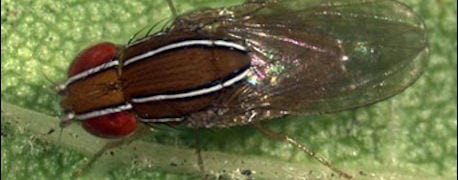February 5, 2014

University of Minnesota scientists have confirmed a new invasive fruit fly in Minnesota.
A single adult female, commonly known as the African Fig Fly, recently was discovered in a fermenting bait trap from late September 2013.
The trap was located near Hastings and was being used for annual monitoring of spotted wing Drosophila (SWD), itself a newly invasive Drosophilid.
The new fly specimen, Zaprionus indianus Gupta (Diptera: Drosophilidae), was officially identified last week by the U.S. Department of Agriculture.

African Fig Fly, Zaprionus indianus Gupta (Photo: Gary J. Steck)
The African Fig Fly is distinguished from other Drosophila species by a pair of distinctive white stripes, outlined in black, running from the antennae to the tip of the thorax. It is native to tropical Africa, the Middle East and Eurasia and is a typical pest of fig fruits.
The first detection of this species in the United States occurred in 2005 and it has since been found as far north as Michigan and Wisconsin, both reporting their first African Fig Fly in 2012. To date, African Fig Fly populations have remained low in these states.
The African Fig Fly is a generalist feeder and has the potential to affect late season fruits such as grapes, raspberries, blackberries and strawberries. African Fig Fly females primarily lay their eggs only in overripe or previously damaged fruit.
It is currently unknown whether the African fig fly is capable of overwintering in the harsh winters of Minnesota.
Although scientists currently know very little about the survival and potential impact of this fly in Minnesota, the detection of a single fly indicates that any current Minnesota populations are most likely to be small.
"We do not expect the African Fig Fly to pose a significant, immediate threat to Minnesota growers," said Anna Kirk, U-M entomologist. Scientists will continue to monitor for the pest and provide additional information to growers as it becomes available.
For information about the new fruit fly, visit the university's VegEdge web page, http://www.vegedge.umn.edu/
Possible new detections should be sent to the Minnesota Department of Agriculture's "Arrest the Pest Hotline" by email, [email protected]
You May Also Like




